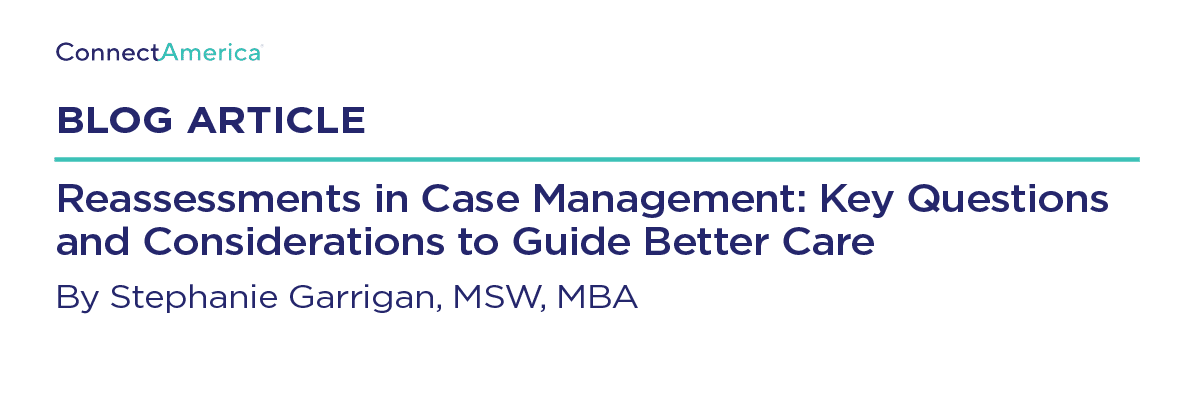Stephanie Garrigan, MSW, MBA
In case management, regular reassessments ensure that each person’s care plan still fits their changing needs, goals, and setting. Done well; reassessments let care teams spot risks early, adjust support, prevent hospitalizations and strengthen trust between the individual and their care team.
The following are some essential questions and considerations to help guide effective assessments for better care.
1) What’s changed since the last assessment?
Start by asking what’s changed.
- Have there been any new diagnoses or hospital admissions?
- Are there new medications, specialists, or treatment changes?
- Has the person noticed increased fatigue, side effects, or new social challenges?
- Compare the current status with prior assessments to identify trends.
This step helps uncover subtle changes before they become emergencies.
2) Is the current care plan still aligned with the client’s goals?
Goals can shift as conditions progress or personal circumstances change.
- Ask if the client’s goals, such as staying independent, improving mobility, or reducing pain, are still current priorities that feel realistic.
- Use compassionate, open conversation so the client feels safe sharing doubts or fears.
- Document any updated goals, adjust coordination activities, and give clear timelines for service changes. Ensuring alignment keeps individuals engaged and ensures the plan stays meaningful.
3) Have functional abilities or support systems changed?
Gauge how the person manages daily life and where extra support might be needed.
- Review activities of daily living (ADLs) such as bathing, dressing, feeding, and mobility.
- Check cognitive status, fall history, and caregiver support levels.
- Reevaluate home safety. Has the living situation changed (for example, moving in with family or into assisted living)?
- Review monitoring tools like a personal emergency response system (PERS):
- Does the person have one?
- Are they using it properly, and has it been tested?
- Does the device type (wearable, GPS, fall-detection) match their current needs?
Identifying changes in function or support means you can proactively arrange therapy, home modifications, or assistive technology.
4) Are social determinants of health influencing care?
Social factors commonly shift and directly affect outcomes.
- Ask about transportation, financial stress, food insecurity, or social isolation.
- If isolation is a concern, discuss activities the individual enjoys and brainstorm how they might re-engage.
- Consider referrals to community resources or adding monitoring tools to restore peace of mind.
Updating these non-clinical components keeps the plan comprehensive and person-centered.
5) Is the client engaged and confident in their plan?
Engagement drives adherence and trust.
- Review the plan verbally before asking for consent.
- Ensure the person understands the services, knows how to reach the care team, and feels comfortable with tools and support.
- Ask if they want to share the plan with a caregiver or advocate and ensure that person has access.
When the person feels in control and supported, they are more likely to follow the plan and speak up early about concerns.
Closing the Loop
Reassessments are a cornerstone of effective case management. By asking the right questions and structuring each review to capture clinical, functional, social, and engagement changes, care teams keep the plan in sync with the client’s life, resulting in fewer risks, stronger relationships, and more successful aging at home.
About the Author:
Stephanie Garrigan is a Senior Account Manager at Connect America’s family of brands, including American Medical Alert and Lifeline. With more than 25 years in clinical social work, she brings a deep understanding of healthcare policies, senior care, and resource challenges. Stephanie holds master’s degrees in social work and business administration with healthcare concentration.

